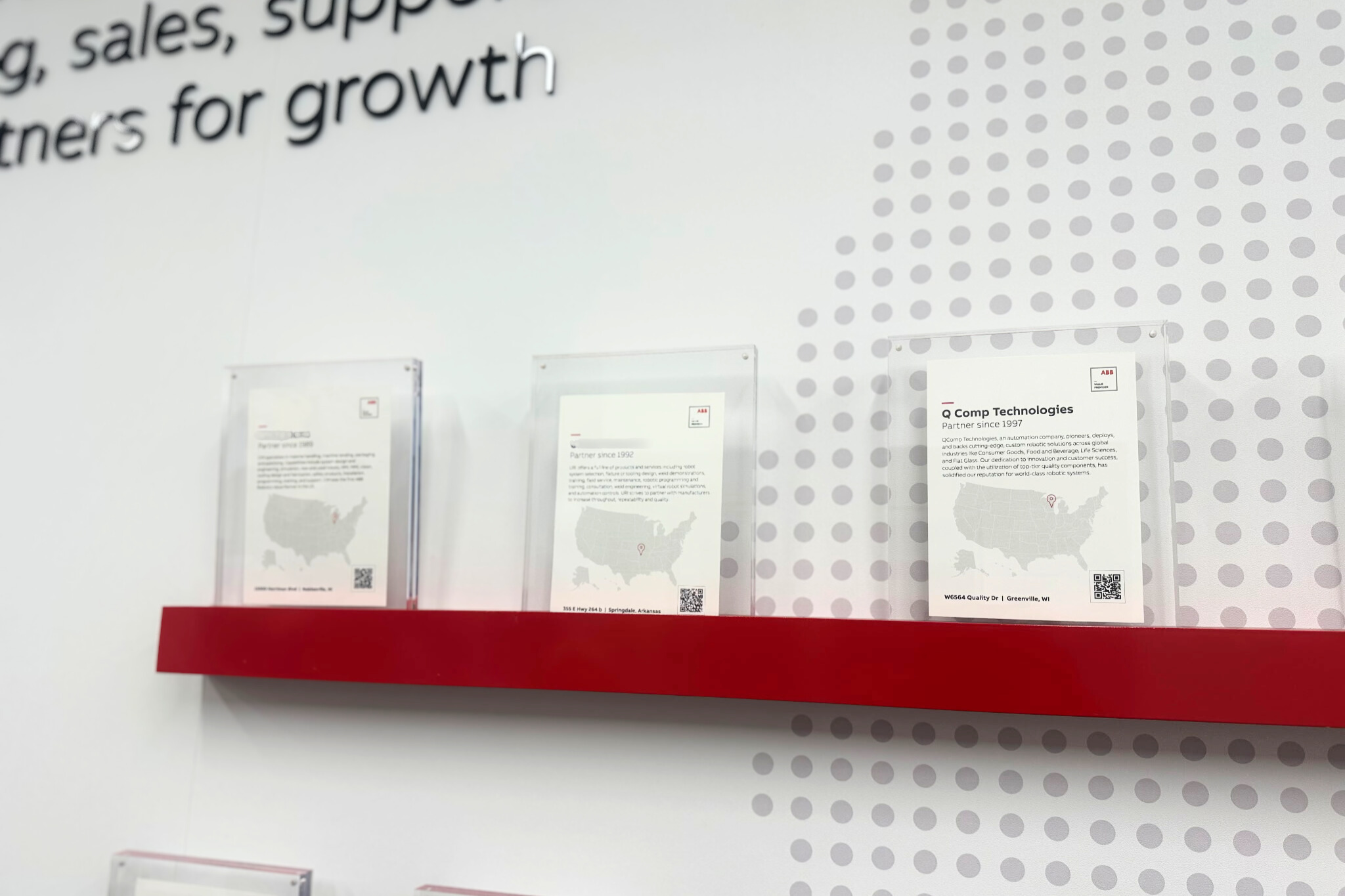Are you considering a robotics integration but think your facility or existing production line can’t accommodate new technologies? Integrating robotics into an existing production line can indeed be complex. Many manufacturers underestimate the planning required, leading to unexpected delays and costs.
In this article, we explore the most common obstacles companies face when adopting robotics and provide insights on how to overcome them for a seamless, efficient, and safe integration process.
RELATED: What Is Proactive Development of Robotic Solutions?
Common Robotics Integration Challenges
Not all manufacturers account for robotic automation when designing their facilities, making it difficult to incorporate a system later on. Too often, companies try to squeeze a robot into a cramped space when a slight reconfiguration — sometimes just a few feet away — would provide a much better solution. In some cases, pedestrian aisleways could be moved to accommodate a robot, but companies sometimes hesitate to make these changes.
While it's understandable that every square foot of a facility carries a cost, unrealistic space expectations can limit automation. The goal should be optimizing efficiency, not just minimizing footprint.
Beyond space, utilities present another common challenge. Robotics often requires compressed air, water connections and, of course, electrical power. Some manufacturers don’t have the necessary infrastructure in place. For example, vacuum systems used in material handling often rely on compressed air, but if a facility doesn’t have the capacity, this can drive up costs and complexity.
One solution is a vacuum blower system that eliminates the need for costly compressed air. While the upfront cost may be slightly higher, it offers long-term savings by reducing energy consumption and maintenance costs.
Similarly, electrical supply and cable management must be considered. Robotic systems can draw significant power, and some facilities may need to upgrade their electrical infrastructure to handle the additional load. This isn’t a simple plug-and-play scenario — high-voltage distribution requires a licensed electrician to ensure compliance and safety. Planning for these upgrades early in the process helps avoid delays and unexpected costs during installation.
Successful robotic integration requires more than just selecting the right equipment — it demands careful planning for space, utilities, and infrastructure. Addressing these factors early on ensures a smoother transition to automation, leading to better efficiency and long-term cost savings.
Items on a Robotic Installation Checklist
There are numerous scenarios in which robotic automation looks good on paper, but doesn’t always translate into an effective solution once installation day comes. Through the years, the integration team at QComp Technologies has encountered numerous challenges that need to be overcome, and we’ve developed an extensive checklist to ensure a smooth installation process.
It all begins with identifying the responsibilities of each party. For example, will the customer pull permits or do they want the integrator to handle that? What about freight transport of the robotic system — does the manufacturer have a preferred carrier or should the robotic integrator arrange delivery?
Once responsibilities are understood, the integrator must verify numerous details, including:
- Docking doors — Are the docking doors and receiving area large enough for the equipment to pass through?
- Verification of a clear path from receiving to installation — What about internal doorways, aisleways, columns, ceiling heights, utility pipes, etc.?
- Power drops and air drops — Are they available?
- Full plant/facility drawings — These are needed early in the process to have foresight and identify opportunities for optimizing space.
- Floor/concrete thickness and load capacity — Can the flooring support the weight of a robotic cell? Is additional reinforcement needed?
- Updates since previous installations — If a robotic integrator installed a solution previously, what changes to the facility have occurred since that could impact a new system?
These are just a few examples of questions that need answers prior to developing a solution. One missed detail could significantly delay completion and result in costly downtime.
Tips for Successful Robotics Integration
A smooth robotic integration starts with clear communication and knowledge transfer between the automation provider and the customer. Many production lines already have existing equipment, such as stretch wrappers or palletizers, that need to interface with the new robotic system. The most efficient way to manage this is by having someone on site with a deep understanding of the current equipment — its PLC type, firmware version, and network requirements. This helps the integration team determine whether an Ethernet connection, IoT integration, or other communication methods are necessary. The earlier this collaboration happens, the better, as it reduces surprises and streamlines installation.
Collaboration with operators and end-users is also key. The people who will work with the robotic system daily can provide valuable insights that might not be obvious during planning. For example, when integrating a palletizer or a glass-handling system, a standard solution may work — but customization could enhance efficiency based on the user’s workflow. Likewise, having access to the customer’s software backups and system configurations can simplify setup, especially when dealing with older equipment. In some cases, legacy systems may be too outdated or pose safety risks, requiring alternative solutions that prioritize safety first and cost second.
Not every robotic system needs full integration with existing controls. Sometimes, a simple sensor is enough to ensure smooth operation. For example, adding a single sensor to a conveyor could provide all the necessary data about upstream processes, eliminating the need for complex control tie-ins. A well-placed sensor could detect if a case erector is malfunctioning, preventing downtime without requiring a full system overhaul.
By combining smart planning, early collaboration, and the right level of integration, manufacturers can achieve a seamless transition to robotics while maintaining efficiency and safety.
Prioritizing Safety & Compliance
Safety is a critical factor in robotic integration, and emergency stop (e-stop) functionality must not create a false sense of security. A key question is whether the robotic integrator’s e-stop should stop the customer’s equipment or vice versa. Typically, operators expect an e-stop to shut down the entire zone — including the robot and any connected conveyors.
To ensure this, QComp conducts risk assessments with the customer’s team, identifying hazards, setback distances, and shutdown protocols early in the process. Safety validation is also a crucial step. Our team documents all safety settings and tests the system both at our facility and on-site after installation. This ensures that when an e-stop is activated, it performs exactly as intended, keeping operators and equipment safe.
Integrating Robotics Into an Active Production Environment
Successfully integrating robotics into an active production environment requires careful planning and coordination between the customer, contractors, and the robotics team. Establishing a clear timeline helps minimize disruptions, and in some cases, customers can build ahead to maintain product shipments during installation.
A robotics integrator can also accommodate schedules by working after hours, on weekends, or even around the clock. The more planning that happens in advance — such as aligning installation with scheduled maintenance shutdowns — the smoother the process will be.
It’s also crucial that the customer’s existing equipment is stable and running as expected before installation. Unexpected control changes between planning and implementation can create delays, so alignment throughout the process is key.
At QComp, we work closely with our customers to anticipate challenges, develop solutions, and ensure a seamless transition to automation. If you're considering integrating robotics into your production line, connect with the QComp team today to explore how we can help optimize your operations.
Share this
You May Also Like

QComp: Proud to Be One of the First ABB Value Providers in the World
QComp was the third company in the world to join ABB’s Value Provider Program. Discover how decades of partnership and proven expertise help us deliver smarter, certified automation solutions that conquer complexity.

How Customized Automation Delivers High ROI
Discover how robotic automation drives ROI, improves productivity, and addresses labor challenges in this insightful conversation with QComp experts.

The Automation Advantage: Combat Labor Shortages and Win the Talent War
Discover how automation can help manufacturers tackle labor shortages, improve safety, and achieve a positive ROI in this insightful blog post conversation between industry experts.
